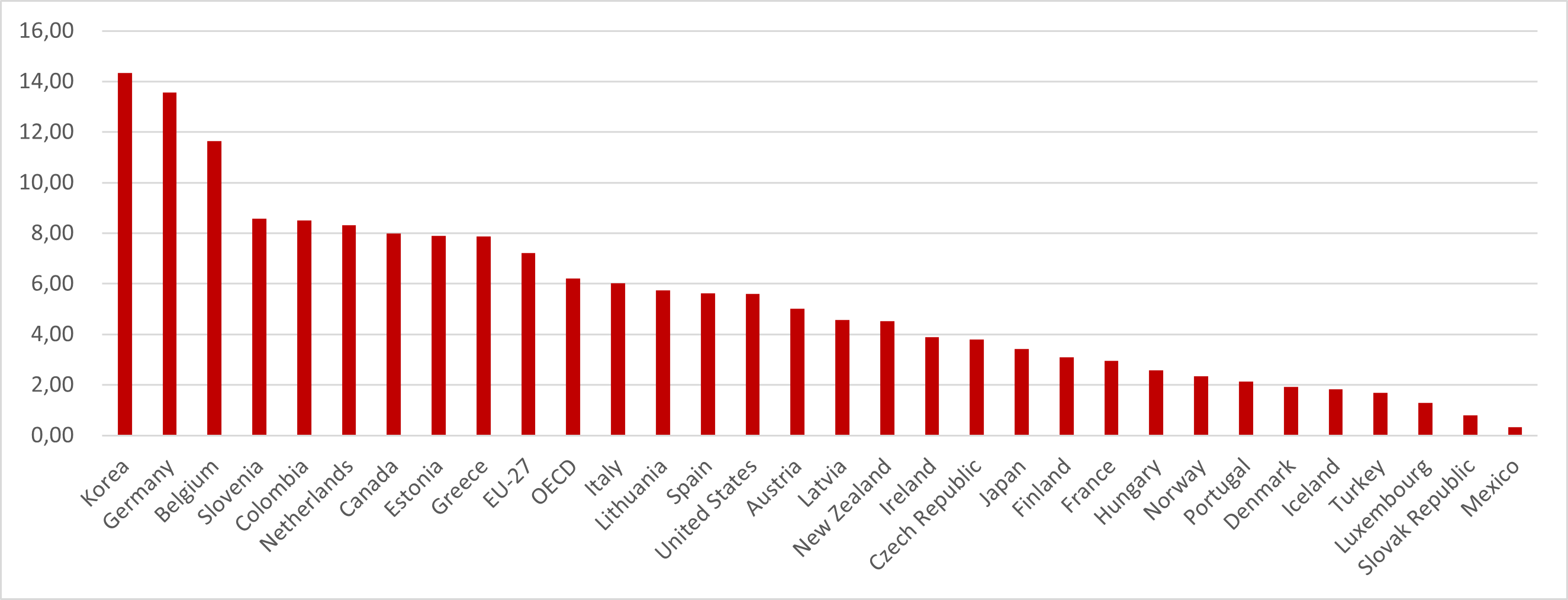What information can U-Multirank provide us about university-business cooperation in research, development and innovation (RDI)?
March 22, 2022 11:55 (CET)
Ángela Mediavilla. Fundación CYD/CYD Foundations

In a previous post, we considered how U-Multirank could help us if we were thinking of starting a research career. In it we offered you a series of indicators that enabled you to compare the performance of universities worldwide in research. But, once you have analysed which universities and university systems stand out in this respect, it is worth considering a further question: How do universities collaborate with research organisations, companies and other bodies to transfer this knowledge that has been created to society as a whole?
At an international level, the research carried out in universities and other public research institutions can represent a very substantial part of the research undertaken in the country, but we also need to analyse whether there is the necessary cooperation with the private sector to transfer these research results from the university sector to the rest of society. In this respect, U-Multirank can also offer us interesting information on the degree of collaboration between universities and the private sector in terms of research, development and innovation (RDI).
Let’s start by providing some statistics to put this all in a broader context: in the first place, the percentage of higher education R&D financed by the business sector in 2019 in the OECD countries shown in graph 1. In overall terms, it reveals that the level represented by the private sector in the financing of R&D in higher education is relatively low. Countries such as South Korea (14.33%), Germany (13.56%) and Belgium (11.65%) stand out for having levels above the average of the EU-27 countries (7.21%) and the OECD (6.22%).
Graph 1. Percentage of higher education R&D financed by the business sector, 2019.

Source: Main Science and Technology Indicators, OCDE.
Data extracted on 03 Mar 2022 15:22 UTC (GMT) from OECD.Stat
Secondly, we should mention the percentage of innovative companies that cooperate with higher education and government institutions. This information is derived from the OECD Innovation Statistics 2019, based on national innovation surveys and the Community Innovation Survey and is shown in Graph 2. There are countries like the United Kingdom where there is a high percentage of groundbreaking companies cooperating (69%) and, what is more, almost half of them have ties with higher education institutions (HEIs) and government institutions (30%). In the case of the United States, although a large proportion of its companies cooperate in innovation (73%), the level of cooperation with HEIs is far more modest (15%). For countries such as Finland (25%), Austria (25%) and Slovenia (24%), HEIs and government institutions play a prominent role in innovation cooperation with the business sector. However, on average, cooperation in innovation between companies and HEIs is at a level (14%) that is considerably lower than the figures mentioned beforehand.
Graph 2. Firms co-operating on innovation (as a percentage of product and/or process innovation-active firms)

Source: OCDE Innovation Stats, 2019 (http://oe.cd/inno-stats)
Although the situation is uneven between countries, the two graphs reflect how there is scope for manoeuvre to promote closer collaboration between universities and companies, links that might facilitate the transfer of the knowledge generated in universities to the rest of society.
What information can U-Multirank provide us in this regard? U-Multirank considers the transfer of knowledge as one of the missions inseparable from the role of the university world, and for this reason it includes a substantial number of indicators both at the university level and as regards the different fields of knowledge which allow universities to be evaluated in this dimension.
Among the indicators that are included, we find: Income from private sources, which measures the external research revenues from private sources, revenues from Continuing Professional Development activities, revenues from licensing, copyrighted products and royalties, Co-publications with industrial partners, which refers to the percentage of the university's research publications that list an author affiliate with an address referring to a for-profit business enterprises or private sector R&D unit), Industry co-patents defined as the percentage of the number of patents assigned to inventors working in the university, which were co-applied with at least 1 applicant from the industry, Spin-offs calculated as the number of spin-offs (i.e. firms established on the basis of a formal knowledge transfer arrangement between the institution and the firm) recently created by the institution (per 1000 FTE academic staff, excluding FTE doctoral candidates counted as staff), or Publications cited in patents, which takes into account the percentage of the university's research publications that were mentioned in the reference list of at least one international patent (as included in the PATSTAT database).
For more information, you can consult a more complete definition of each of these indicators and of all those included in the institutional ranking and in those referring to the full range of academic fields.




